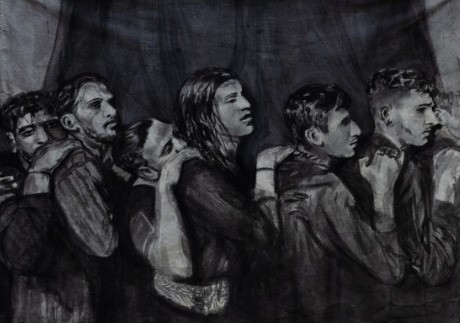Ali Rizvi delves into the heart of Shia Jaloos
گھونٹ پانی کا نا اصغر کو لبِ دریا ملا
پھول باغِ فاطمہ کا بِن کھلے مرجھا گیا
I was born in a shia family, and for some time I did not know what that meant for me. Growing up, my mother told us stories of Karbala that we would listen with an interest and sorrow. I remember, as soon as we started walking properly and going to school, my father gave me a zanjeer to participate in the matam in our village. As I got older, I started asking questions and grew distant from my religion. I haven’t found my way back, I am standing somewhere in between. As an individual and particularly after my thesis, while I enjoy my devotion, I have always been critical and have kept humanity as a priority.
Muslim children in Pakistan, from a very young age, realise that there are ‘Shia’ and ‘Sunni’ and that there are stories and surnames associated with each belief. And, as much as they are often asked ‘What are you?’, they are rarely taught with the same enthusiasm, that both people frequently walk the same paths of hope, reverence and a quiet sense of belonging. Ali’s expansive ink work nudges the viewer into a comprehension process in which they consider their place within the mosaic of believers, each individual contributing to a bigger, vibrant picture of devotion.
‘I weave a tapestry of emotions, capturing a moment suspended in time’, Says Ali.
In Neil Jordan’s Carnivalesque, a young boy slips into a hall of mirrors, and he discovers another magical world defying reality. It becomes an adolescent’s journey in which he confronts himself; losing and finding his identity over and over.
Ali is driven by the pulse of human connections. He presents canvases as portals to explore the human experience, and his audience eventually becomes a part of the shared energy of an imminent event. His visual language contains multitudes of the seen and unseen, flesh and blood bound by a promise.
When I am part of the Jaloos, I see different paintings, compositions, shades of light and emotions. On 10th Muharram, I am responsible for distributing zanjeers, langar, and preparing the perfect shade of blood red for horse sculptures with my uncle, another artist in the family. I enjoy the cultural practices, I find them rewarding. During these practices, there is a time when it’s about my guilt and regrets more than the event itself, that translates into my work.
Being a Shia or being a Sunni means different things for different people. It is wildly divergent, as Feisal Hussain Naqvi writes in his article for 3 Quarks Daily, on his personal experiences travelling between regions and seeing his faith transform through time.
During Ali’s annual visits to Mochi Darwaza in Muharram, he keeps the company of Shaaday Bhai, an amazing cook of Halwa and Tea:
Shaaday Bhai would start with ‘Badshah, app cigarette lagain gey aaj? (Will you light up a cigarette today?)
Ali will inspect his surroundings to confirm that there are no family members around. ‘Jee Shaaday bhai, zaroor’ (Yes, Shaaday bhai, definitely)
Shaaday Bhai, 40 years old, would take out a joint from his pocket and fire it up.
Ali would ask ‘Shaaday Bhai, aap ki shaadi hogae hai, bachay aapkay?’ (Shaaday Bhai, are you married? Your kids?)
‘Nae, mainay shaadi nae ki’ (No, I did not marry), says Shaaday bhai.
Ali would then ask ‘Kyun, khairirat?’ (Why, all well?)
‘Muharram duties mein itna time lag jata hai. Aik larki pasand thi usko in cheezon sey maslay thay. Phir mainay chars sey hi shaadi karli. Ab mein poori sangat keh liye khaana banata hun aur smoke karta hun.’ (Muharram duties take up a lot of time. I liked a girl but she did not approve of these practices, so I married cannabis. Now I cook for people and smoke)
The people in Ali’s work, standing alone or in a crowd, mirror the unique and defining journeys of countless believers across time. The contrast between them and their surrounding is an intangible bond bringing their histories and stories into a shared space. Each figure is a testament to the human desire for connection and the yearning to transcend the mundane.
ہائے بعدِ مصطفیٰ (ص) کیسا زمانہ آگیا
عین جس جاہ پر پڑی تھی بے کفن لاشِ حسین
زینب و کلثوم کو اس جاہ سے لایا گیا
When we are young, we don’t understand the cycles that have continued to intensify the concept of ‘others’. As we grow old, we start to see the reactionary psychology of ‘this versus that’ resulting in a lack of margins that has hurt our people and stained our history.
As a visual artist charting different realms of devotions, culture, commune and politics, Ali aptly states, ‘Ultimately, my canvas becomes a mirror that reflects not just a crowd, but a collective journey’.
Image: Naam e Mola, Ali Rizvi, ink on canvas, all copyrights retained by the artist 2024.
